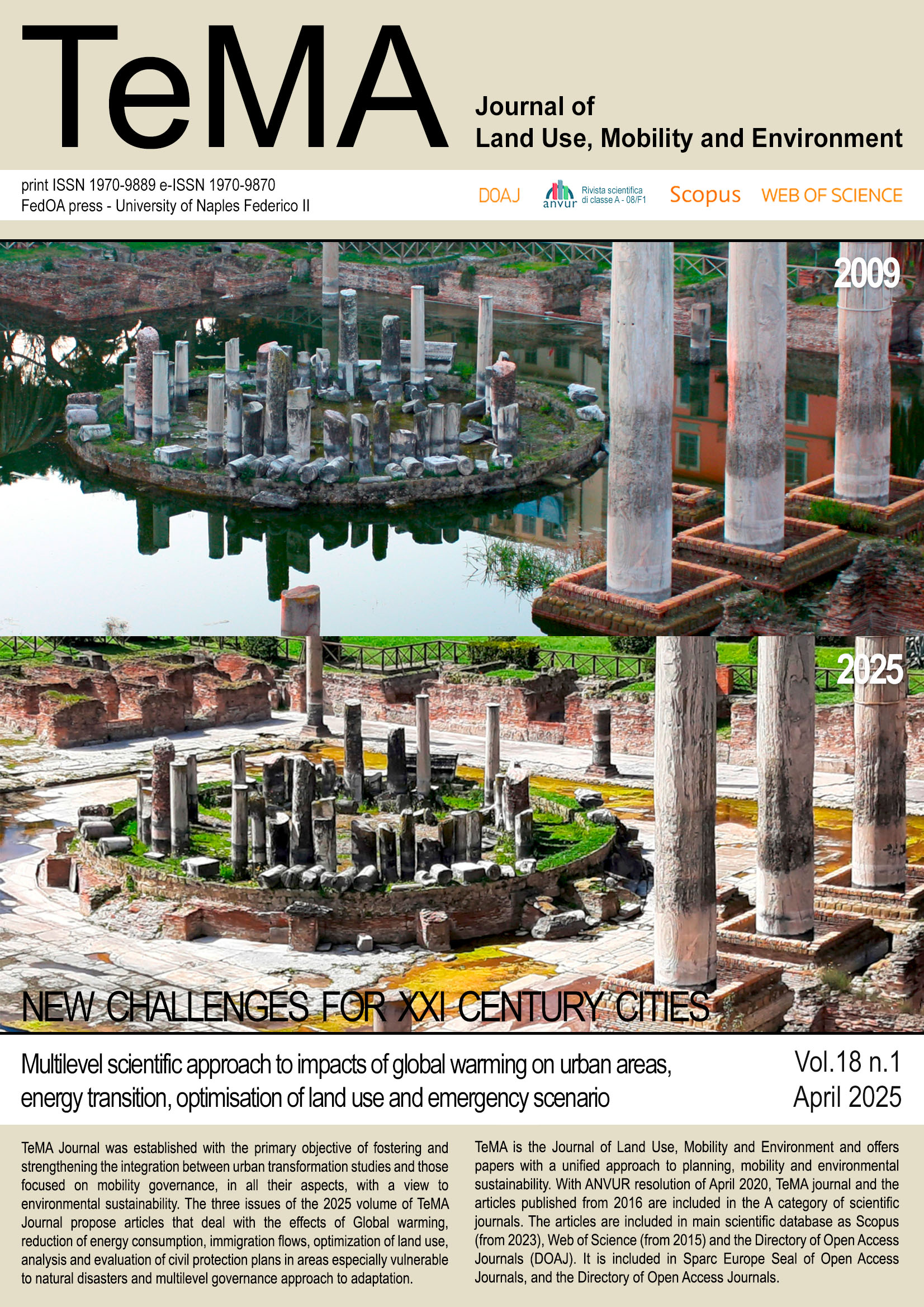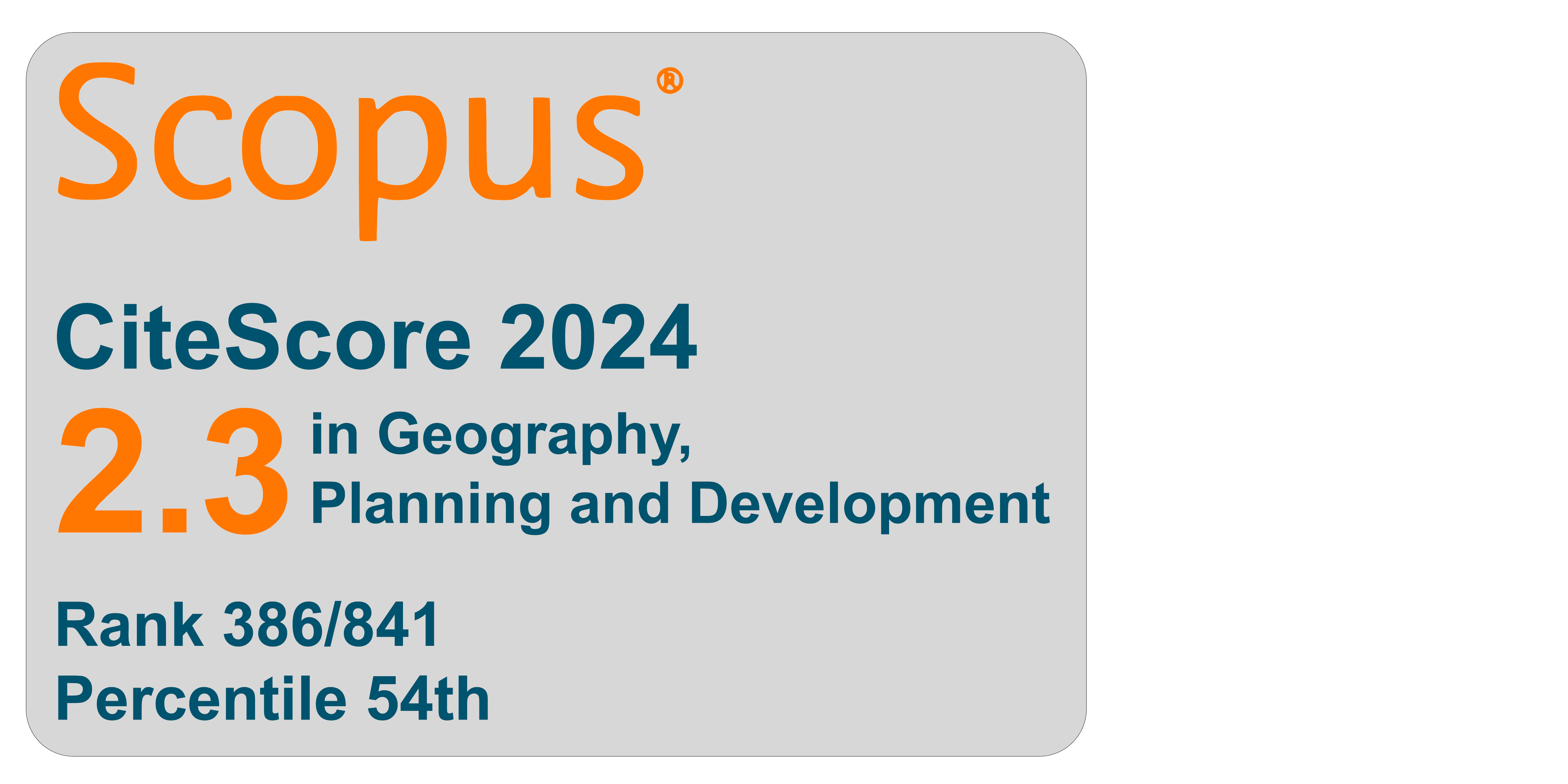Definition of spatio-temporal levels of accessibility. Isochronous analysis of regional transport networks
DOI:
https://doi.org/10.6093/1970-9870/11146Keywords:
Accessibility, Isochronous analysis, Spatial equityAbstract
Accessibility to transport networks affects the ability of citizens to carry out necessary activities in their daily lives. In particular, in small and medium-sized centres where only some essential services retain a proximity attribute, we are seeing an increasing number of daily travels, the distances travelled and the time taken by local citizens for primary (work, health, education, etc.) and secondary (leisure, etc.) mobility needs. In polycentric and widespread territorial contexts, such as those typically Italian, accessibility is therefore synonymous with spatial equity. In this disciplinary debate, the present research aims to analyse analytically the levels of accessibility of individual administrative units to the main transport networks. To this end, a semi-automated method in GIS environment for the definition of municipal levels of space-time accessibility is proposed based on an isochronic analysis conducted on access nodes to major transport, motorway and rail networks, at the territorial scale. The paper also presents the results obtained from the method application in the Calabrian regional context useful to support the adoption of a planning approach oriented towards territorial integration between mobility needs and the programming of the network of services that typically characterizes the urban planning discipline.
Downloads
References
Alberti, F. & Marzi, L. (2022). Visioni e strumenti per un’urbanistica dell’accessibilità. URBANISTICA, 164, 49-53.
Allen, J. & Farber, S. (2020). Planning transport for social inclusion: An accessibility-activity participation approach. Transportation Research Part D: Transport and Environment, 78, 102212. https://doi.org/10.1016/j.trd.2019.102212
Altay, E. E. & Şenay, D. (2023). Usability and accessibility of urban service areas with increasing epidemics: the case of Bursa/Turkey. TeMA - Journal of Land Use, Mobility and Environment, 16(1), 147-163. https://doi.org/10.6093/1970-9870/9591
Bertram, D. & Chilla, T. (2023). Polycentricity and accessibility in mountain areas: the Alpine case. European Planning Studies, 31 (12), 2425-2445. https://doi.org/10.1080/09654313.2022.2145874
Borlini, B. & Memo, F. (2009). Ripensare l'accessibilità urbana. Cittalia Fondazione Anci ricerche, 2.
Canu, D. (2016). Misure di accessibilità nella valutazione dell’equità urbana: una raccolta dei metodi. Archivio Di Studi Urbani E Regionali: 116, 2 (2016), 115-138, Milano: Franco Angeli. https://doi.org/10.3280/ASUR2016-116006
Cargnin, M. J., de Castro Marino, C. & da Silva, T. L. (2024). The 15-minute cities concept applied to a Brazilian neighborhood: case study of the cidade universitária Pedra Branca neighborhood in Palhoça-SC. TeMA - Journal of Land Use, Mobility and Environment, 17 (2), 189-191. https://doi.org/10.6093/1970-9870/10314
Carrosio, G. & Barca, F. (2020). Un modello di policy place-based: la Strategia nazionale per le aree interne. In G. Osti & E. Jachia. AttivAree. Un disegno di rinascita delle aree interne, 63-72, Bologna: Il Mulino.
Cascetta, E., Cartenì, A., Henke, I. & Pagliara, F. (2020). Economic growth, transport accessibility and regional equity impacts of high-speed railways in Italy: Ten years ex post evaluation and future perspectives. Transportation Research Part A: Policy and Practice, 139, 412-428. https://doi.org/10.1016/j.tra.2020.07.008
Cerasoli, M. (2024). Infrastrutture, accessibilità e aree interne. Urbanisticatre, NU3(5), 65-74.
Chen, J., Cui, M. & Levinson, D. (2024). The cost of shopping: measuring virtual and physical access for obtaining goods. TeMA - Journal of Land Use, Mobility and Environment, 17 (1), 129-145. https://doi.org/10.6093/1970-9870/10688
Costa, V. & Delponte, I. (2024). User-centred mobility management and social inclusion. Urban insights from the University of Genoa. TeMA - Journal of Land Use, Mobility and Environment, 33-45. https://doi.org/10.6093/1970-9870/10299
D'Amico, A. (2024). Strategies and instruments for active mobility: the main Italian policies. TeMA - Journal of Land Use, Mobility and Environment, 17 (3), 509-515. https://doi.org/10.6093/1970-9870/11166
Di Ruocco, I. (2022). Resilient marginal cities by encouraging intermodality strategies. TeMA - Journal of Land Use, Mobility and Environment, 15 (3), 377-396. https://doi.org/10.6093/1970-9870/9031
Erçetin, C. (2024). Right-based approach to urban accessibility: analysis of user perspective. TeMA - Journal of Land Use, Mobility and Environment, 17 (2), 249-264. https://doi.org/10.6093/1970-9870/10510
European Union (2023). Parlamento Europeo. Tratto da https://www.europarl.europa.eu/doceo/document/TA-9-2023-0130_IT.html
Fazio, M., Borghetti, F., Giuffrida, N., Le Pira, M., Longo, M., Ignaccolo, M., Inturri, G. & Maja, R. (2023). The “15-minutes station”: a case study to evaluate the pedestrian accessibility of railway transport in Southern Italy. Transportation Research Procedia. https://doi.org/10.1016/j.trpro.2023.02.205
Gargiulo, C., Maternini, G., Tiboni, M. & Tira, M. (2022). New scenarios for safe mobility in urban areas. TeMA - Journal of Land Use, Mobility and Environment, 3-5. https://doi.org/10.6093/1970-9870/8916
Gkiotsalitis, K. & Cats, O. (2021). At-stop control measures in public transport: Literature review and research agenda. Transportation Research Part E: Logistics and Transportation Review, 145, 102176. https://doi.org/10.1016/j.tre.2020.102176
Große, C. (2024). Envisioning sustainable rural development: A narrative on accessibility and infrastructure from a Swedish region. Journal of Rural Studies, 109 (103319). https://doi.org/10.1016/j.jrurstud.2024.103319
Handy, S. (2020). Is accessibility an idea whose time has finally come?. Transportation Research Part D: Transport and Environment, 83, 102319. https://doi.org/10.1016/j.trd.2020.102319
Higgins, C. D. (2019). Accessibility toolbox for R and ArcGIS. Transport Findings. https://doi.org/10.32866/8416
Hillel, T., Bierlaire, M., Elshafie, M. Z. & Jin, Y. (2021). A systematic review of machine learning classification methodologies for modelling passenger mode choice. Journal of choice modelling, 38, 100221. https://doi.org/10.1016/j.jocm.2020.100221
Huang, X., Kang, C., Yin, C. & Tang, J. (2024). Influence of Transportation Accessibility on Urban-rural Income Disparity and Its Spatial Heterogeneity. Chinese Geographical Science, 34 (3), 453-467. http://doi.org/10.1007/s11769-024-1427-8
Jian, I. Y., Luo, J. & Chan, E. H. (2020). Spatial justice in public open space planning: Accessibility and inclusivity. Habitat International, 97, 102122. https://doi.org/10.1016/j.habitatint.2020.102122
Kurlov, A. V., Materuhin, A. V., Dresvyanin, A. V. & Gvozdev, O. G. (2022). Geoinformational Approach to Assessing the Accessibility for Urban Areas. Tomsk: 2022 International Siberian Conference on Control and Communications, SIBCON 2022.
Lahoorpoor, B. & Levinson, D. M. (2020). Catchment if you can: The effect of station entrance and exit locations on accessibility. Journal of Transport Geography, 82, 102556. https://doi.org/10.1016/j.jtrangeo.2019.102556
Lin, X., Shaozhuang, W. & Lingxiao, Y. (2024). Distributional effects of expressway access on rural entrepreneurial activities in China. Socio-Economic Planning Sciences, 94 (103319). https://doi.org/10.1016/j.seps.2024.101964
Lü, G., Batty, M., Strobl, J., Lin, H., Zhu, A. X. & Chen, M. (2019). Reflections and speculations on the progress in Geographic Information Systems (GIS): a geographic perspective. International journal of geographical information science, 33 (2), 346-367. https://doi.org/10.1080/13658816.2018.1533136
Massaro, A. & Rotondo, F. (2020). L'accessibilità urbana come forma di rigenerazione: un'esperienza a Taranto. In XXII Conferenza Nazionale SIU, Roma-Milano: Planum-Publisher.
Melzi, C. (2011). Qualità della vita ed equità socio-territoriale nelle aree metropolitane di Bologna, Milano e Torino. Uno studio empirico sulla mobilità territoriale e l'accessibilità ai servizi di prossimità. Università di Milano-Bicocca.
Merengo, M. (2023). Le aree rurali contemporanee fra rural gentrification e lifestyle migration. Studi di caso in Francia e in Italia. In M. Merengo (A cura di), La "Rinascita" dei territori marginali. Dalla desertificazione socio-demografica e funzionale alla gentrification rurale e le lifestyle migrations, 40-55, Genova: Genova University Press.
Montero-Lamas, Y., Fernández-Casal, R., Varela-García, F. A., Orro, A. & Novales, M. (2024). A spatial statistical approach to estimate bus stop demand using GIS-processed data. Journal of Transport Geography, 118 (103906). http://doi.org/10.1016/j.jtrangeo.2024.103906
Mouratidis, K. (2021). Urban planning and quality of life: A review of pathways linking the built environment to subjective well-being. Cities, 115, 103229. https://doi.org/10.1016/j.cities.2021.103229
Pamucar, D., Deveci, M., Canıtez, F., Paksoy, T. & Lukovac, V. (2021). A novel methodology for prioritizing zero-carbon measures for sustainable transport. Sustainable production and consumption, 27, 1093-1112. https://doi.org/10.1016/j.spc.2021.02.016
Pucci, P., Carboni, L. & Lanza, G. (2022). Accessibilità di prossimità in un territorio montano. Archivio di studi urbani e regionali, 135, 3, 2022, 5-26. http://doi.org/10.3280/ASUR2022-135001
Śleszyński, P., Olszewski, P., Dybicz, T., Goch, K. & Niedzielski, M. A. (2023). The ideal isochrone: Assessing the efficiency of transport systems. Research in Transportation Business & Management, 46 (100779). http://doi.org/10.1016/j.rtbm.2021.100779
Stiuso, T. (2024). Exploring approaches and solutions for urban safety: a focus on the elderly. TeMA - Journal of Land Use, Mobility and Environment, 17 (3), 525-533. https://doi.org/10.6093/1970-9870/11172
Vilhelmson, B. (1999). Daily mobility and the use of time for different activities: the case. GeoJournal, (48), 177-185. http://doi.org/ 10.1023/A:1007075524340
Vitale Brovarone, E. & Cotella, G. (2020a). Improving rural accessibility: A multilayer approach. Sustainability, 12 (7), 2876. https://doi.org/10.3390/su12072876
Vitale Brovarone, E. & Cotella, G. (2020b). La Strategia Nazionale per le Aree Interne: una svolta place-based per le politiche regionali in Italia. Archivio di studi urbani e regionali: 129, 3, 2020, 22-46, Milano: Franco Angeli. http://doi.org/10.3280/ASUR2020-129002
Wang, S., Wang, M. & Liu, Y. (2021). Access to urban parks: Comparing spatial accessibility measures using three GIS-based approaches. Computers, Environment and Urban Systems, 90, 101713. https://doi.org/10.1016/j.compenvurbsys.2021.101713
Xi, Y., Miller, E. J. & Saxe, S. (2018). Exploring the Impact of Different Cut-off Times on Isochrone Measurements of Accessibility. Transportation Research Record, 2672 (49), 113-124. http://doi.org/10.1177/0361198118783113
Xu, M. (2014). A GIS-based pedestrian network model for assessment of spatial accessibility equity and improvement prioritization and its application to the Spoken Public Transit benefit area. Washington: Washington State University.
Yang, Z., Liu, Y., Luo, X., An, R. & Jiang, Y. (2022). Evaluation of the rural accessibility at a county level from the coupling perspective of “Threshold-Supply and Demand”. Nongye Gongcheng Xuebao/Transactions of the Chinese Society of Agricultural Engineering, 38 (11), 279-288.
Zhao, Y. & Zhou, Y. (2024). Isochrone-Based Accessibility Analysis of Pre-Hospital Emergency Medical Facilities: A Case Study of Central Districts of Beijing. ISPRS International Journal of Geo-Information, 13 (8). https://doi.org/10.3390/ijgi13080288
Zheng, Q. Y., Law, T. H., Wong, S. V. & Ng, C. P. (2024). Relative improvements between roads and railways and economic performance: A panel data analysis. Transport Policy, 153, 87-96. https://doi.org/10.1016/j.tranpol.2024.05.012
Downloads
Published
How to Cite
License
Copyright (c) 2025 TeMA - Journal of Land Use, Mobility and Environment

This work is licensed under a Creative Commons Attribution-NonCommercial 4.0 International License.



